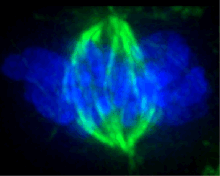- Spindle apparatus
-
This article is about the cellular structure. For other uses, see Spindle (disambiguation).
 Micrograph showing condensed chromosomes in blue and the mitotic spindle in green during prometaphase of mitosis
Micrograph showing condensed chromosomes in blue and the mitotic spindle in green during prometaphase of mitosis
In cell biology, the spindle fibers are the structure that separates the chromosomes into the daughter cells during cell division. It is part of the cytoskeleton in eukaryotic cells. Depending on the type of cell division, it is also referred to as the mitotic spindle during mitosis and the meiotic spindle during meiosis.
Contents
Shape and components
The cellular spindle apparatus includes the spindle microtubules, associated proteins, and any centrosomes or asters present at the spindle poles.[1] The spindle apparatus is vaguely ellipsoid in shape and tapers at the ends. In the wide middle portion, known as the spindle midzone, antiparallel microtubules are bundled by kinesins. At the pointed ends, known as spindle poles, microtubules are nucleated by the centrosomes in most animal cells. Acentrosomal or anastral spindles lack centrosomes or asters at the spindle poles, respectively, and occur for example during gametogenesis in animals.[2] In fungi, spindles form between spindle pole bodies embedded in the nuclear envelope. Most plants lack centrosomes or spindle pole bodies and instead spindle microtubules are nucleated on their nuclear envelopes.[3] The spindles take the cell's chromosomes through most stages of mitosis. They start to form in early metaphase and are connected to the centrioles at each end of the cell.
Regulation of spindle assembly
Aurora A is required for proper spindle assembly and separation.[citation needed] There have been identified many proteins necessary for the mitotic spindle assembly. Lamin B is not essential protein for spindle assembly. It is only a component of the spindle matrix helping microtubule assembly, since proper mitotic spindle can be formed without it.[4]
Polo-like kinase, also known as PLK, especially PLK1 has important roles in the spindle maintenance by regulating microtubule dynamics.[5]
Mitotic spindle assembly checkpoint
The completion of spindle formation is a crucial transition point in the cell cycle called the spindle assembly checkpoint. If some chromosomes are not properly attached to the mitotic spindle by the time of this checkpoint, the onset of anaphase will be delayed.[6] Failure of this spindle assembly checkpoint can result in aneuploidy and may be involved in aging and the formation of cancer.[7] Abnormal mitotic spindles can produce tripolar mitosis. These are clearly abnormal cases and, if present, are considered definitive evidence that a tumor is malignant rather than benign. Such abnormalities are therefore often searched for in histological assays by pathologists when evaluating the potential malignancy of a tumor mass.
References
- ^ Campbell, Neil A.; Jane B. Reece (2005). Biology, 7th Edition. San Francisco: Benjamin Cummings. pp. 221–224. ISBN 0-8053-7171-0.
- ^ Manandhar Gf, Schatten H, Sutovsky P (2005). "Cfentrosome reduction during gametogenesis and its significance". Biol. Reprod. 72 (1): 2–13. doi:10.1095/biolreprod.104.031245. PMID 15385423.
- ^ Schmit AC (2002). "Acentrosomal microtubule nucleation inzeff higherd plants". Int. Rev. Cytol.. International Review of Cytology 220: 257–89. doi:10.1016/S0074-7696(02)20008-X. ISBN 9780123646248. PMID 12224551.
- ^ M. Y. Tsai, S. Wang, J. M. Heidinger, D. K. Shumaker, S. A. Adam, R. D. Goldman & Y. Zheng (31 March 2006). "A mitotic lamin B matrix induced by RanGTP required for spindle assembly". Science 311 (5769): 1887–1193. doi:10.1126/science.1122771. PMID 16543417. http://www.sciencemag.org/cgi/content/abstract/1122771v1.
- ^ Peters, U., J. Cherian, et al. ([(2006)]). "Probing cell-division phenotype space and Polo-like kinase function using small molecules". Nat Chem Biol 2 (11): 618–26. doi:10.1038/nchembio826. PMID 17028580.
- ^ Raven, Peter H.; Ray F. Evert, Susan E. Eichhorn (2005). Biology of Plants, 7th Edition. New York: W.H. Freeman and Company Publishers. pp. 59. ISBN 0-7167-1007-2.
- ^ Baker DJ, Chen J, van Deursen JM (2005). "The mitotic checkpoint in cancer and aging: what have mice taught us?". Curr. Opin. Cell Biol. 17 (6): 583–9. doi:10.1016/j.ceb.2005.09.011. PMID 16226453.
Categories:- Cell anatomy
- Mitosis
Wikimedia Foundation. 2010.
